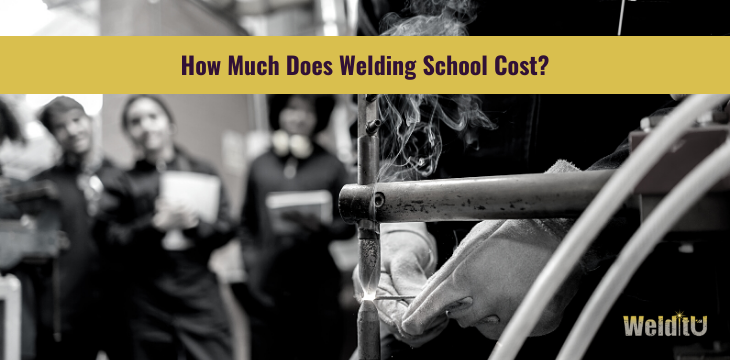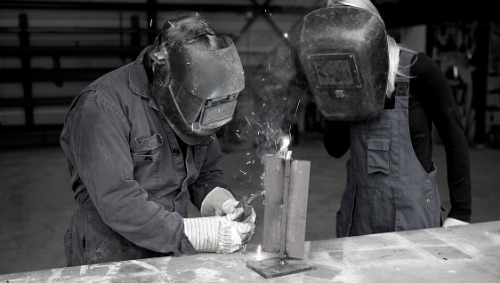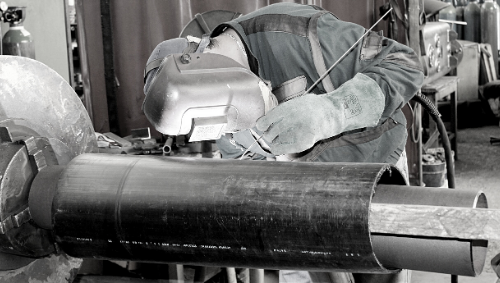If you are considering becoming a welder, training will be the most important factor in determining the type of welding career you settle into. But training in the most recent welding technologies comes at a price. How much will welding school cost you?
Most welding training schools cost between $3,000 and $20,000, with the average tuition to earn your certification of $7,000 to $9,000. The average cost of a two-year welding degree is $19,000, and the price of a four-year bachelor’s degree in welding is over $40,000.
In this article:
- Training Path for a Professional Welder
- What Does Welding School Cost?
- How to Pay for Welding School?
- Expenses Beyond Welding School
- Is Welding School Worth the Cost?

Training Path for a Professional Welder
- Earn High School Diploma or GED – Take related courses such as Shop, Math, Physics, Chemistry and Computers.
- Post-Secondary Welding Training – Receive instruction through vo-tech, trade school, community college, or college courses.
- On-the-Job Training – This varies with employer and your position.
- Welding Certification – Certifications for a particular skill provided by an employer, industry organization, or a welding school. Normally involves a test or inspection.
This article focuses on the cost of post-secondary welding training schools.
What Does Welding School Cost?
Training School (Certificate Programs)
Welding schools offer students an education on the basics of welding. Most of these schools teach standard courses like Shop, Math, Mechanical Drawing, Blueprint Reading, Chemistry, and Computer courses.
These courses help students prepare for entry-level jobs and apprenticeships. Courses are mainly taken as in-person classes. They award certificates upon completion of a 20-30 unit course, which covers the basics of welding. These courses require both in-person and online attendance.
Gas Metal Arc (MIG), Shielded Metal Arc (SMAW), and Gas Tungsten Arc Welding(TIG) are three of the most common processes taught. The student will earn a certificate upon completion of the course, which usually lasts around 9 to 18 months.
A standard entry-level certificate program will suffice for those who wish to move directly into an apprenticeship.
Cost of Training Schools
Training schools can cost anywhere from $5,000 to $15,000. The average cost of welding school is around $9,000 and lasts about 10 months. College of DuPage offers a comprehensive welding program that costs $5490. Books and supplies often cost around $300–$500. Application fees are around $100–$200, and the student must cover housing and meals.
The Structural Welding program at the Hobart Institute of Welding Technology costs around $12,000.
Training schools often offer specialized welding courses, not part of the standard curriculum. These courses lead to certification in specific skills within the trade. They do not include the cost of these courses in the basic tuition, and prices vary depending on the details of each course.

Associate’s Degree in Welding
Another way to pursue a career in welding is to go to college and graduate with an A.A.S. degree. This may be a good career option for those who want to get a college degree while pursuing their welding career.
Completing a welding technology program will give the student a broader understanding of the welding field and will include courses that most training schools do not; such as drafting or fabrication. Beyond these courses, students may pursue more specialized degrees that are often part of a community college A.A. welding degree program. These are two-year programs.
Cost of an A.A.S. Degree
The cost for the Associate of Applied Science in welding at Idaho State University (ISU) is $19,000. This is a typical cost of such degree programs around the country. Besides tuition, the cost includes books, supplies and tools and other fees.
Bachelor’s Degree in Welding
Most students in bachelor’s welding programs intend on becoming welding inspectors, managers, engineers, etc. These programs teach metallurgy, engineering, design, and leadership courses. Because students in B.A. programs gain a deeper understanding of the science behind the process, they graduate with the ability to enter the trade at a higher level.
Cost of a B.S.S. Degree
A four-year bachelor’s degree in welding costs $40,000 to $100,000 on average. This includes tuition and an apprenticeship program only.
More on Costs
School options for aspiring welders are many. One feature of schools and colleges that teach welding is the various specialized certifications students can get depending on their specific interests.
For example, many schools will offer courses like ‘fabrication’ or ‘pipe welding’. These courses can be taken at an additional cost or as part of a combination welding program.
To clarify this cost structure, Lane Community College’s cost estimate for ‘fabrication welding’, as part of a 2-year degree course, is $18,577 (housing, tools, books, and fees included). However, this same course can be taken as a 1-year certificate program for $8,500 (same inclusions).
Here’s a 12-minute video tour of a leading welding school:
How to Pay for Welding School?
Welding school tuition can be an issue for many families. Although the cost varies, depending on the school, applicants can expect to pay around $3000–$8000 for a standard entry-level course.
Students can apply for financial aid, government grants, and loans just as at any college or university.
Federal Welding Training Tuition Assistance offers Pell Grants to aspiring welders. Getting one of these loans depends on where you enroll and what your financial situation is. These grants don’t need to be repaid. There are also Federal loans that offer extended repayment options.
However, scholarships are worth applying for within the school as well as with the American Welders Society (AWS). This award also depends on the individual’s finances and the welding program they are enrolled in.
There are plenty of options for the aspiring welder. Tulsa Welding School, in Jacksonville, Florida, is one of the most well-known schools in the industry, see their webpage for grant and scholarship information.

Do I Have to Purchase Tools, Equipment, Etc.?
Yes, most courses require students to purchase their own supplies. But the cost is quite reasonable for basic welding tools and safety gear. This can vary by course, and specialized training may require an additional investment in supplies, but here are items the students at the Lincoln Electric School must bring to welding class:
- Ankle High, Steel-Toed, Safety Shoes
- Safety Glasses w/ Side Shields
- Jacket
- Gloves
- Cap
- Helmet
- Channel Locks or Vise Grips
- Wire Brush
- Chipping Hammer
Expenses Beyond Welding School
Become an Apprentice
Beginning an apprentice is one of the most important milestones for anyone pursuing a career in the trades. As an apprentice, you can earn money. Different apprenticeships have different pay rates for their apprentices. Find information at your local union headquarters.
A typical apprenticeship lasts around four years. Working under an experienced welder provides the real-world training that becomes the foundation of your career. Over time, there will be opportunities to get to know local contractors and tradespeople who become important connections if you ever move into freelance work.
Apprenticeship Costs
There are some initial license fees that an apprentice will have to pay depending on the state. The only other costs that a welder apprentice is subject to are union membership dues. The purchase and maintenance of personal tools will incur a minor cost as well. However, the government or state funds any classroom training.
Become a Certified Welder
AWS is the main certification agency that holds the exams. The exam is taken at AWS approved facility. To become an AWS Certified Welder (CW) you simply pay $50 and pass the exam.
After passing, many new CWs decide to take the A.A. degree program in welding. Others seek employment. Research is necessary at this point. Many of the higher-paying jobs require going back to school for an A.A. degree. The situation will vary, however, from case to case.

Online Courses
Online courses have recently become very popular among experienced welders. Because of the hands-on training needed to enter the trade, online courses for beginning welders are limited. They are instead offered to welders who are well into their careers and wish to develop skills that require more technical know-how.
For example, certification preparation courses are offered to welders who hope to begin inspection work or sales representatives. These exam prep courses are often added after mastering the basics of welding.
Is Welding School Worth the Cost?
Now, having shed some light on the path to becoming a welder, it would be wise to re-evaluate what the individual has to gain from all this effort. From a financial perspective, the trade can be entered for as little as $3000 (the cost of the training school).
However, depending on the specialization, school and training could cost between $15,000 and $20,000. In the long term, this money will be made back. Because of added risks, graduates of an underwater welding school can make $60,000 to over $100,000 per year, while some entry-level welders can earn as little as minimum wage.
This brings us back to the importance of training. Welding has become a multi-faceted trade. The primary four offered at a school like College of DuPage are TIG Welder, MIG Welder, Arc Welder, and Metal Fabricator.
According to the school, the industry is growing. Many welders from the baby-boom generation are retiring. Welders are in relatively high demand. Welding jobs are here to stay.
What Perks Do Welders Enjoy?
1. Entering the trade fast
Welders do not need a college or university degree. Once they receive their welding certification and pass the AWS exam, they are free to start making pretty good money.
Related Reading: How Long is Welding School?
2. Increasing opportunities
As technology advances, new and exciting welding jobs will open up. Welders are also in growing demand, particularly in states like California and Texas.
3. Highly mobile, highly skilled hands-on work.
For some people, an office could never replace having command of an extremely critical, sought-after skill upon which all our bridges and buildings and cars depend on.
When a plumbing system springs a leak under the sink, it’s a minor hassle. When the power gets cut in a classroom no one gets hurt. But if a weld that holds a beam in a building or that holds a kid’s bike frame together fails, it is a much bigger issue.

Join A Rewarding Trade
The expected growth of this profession means welders will become sought after, causing wages to rise. This is already the case in several states around the country, like California, Illinois, and New York.
The trade also offers workers upward mobility. Because of the diverse range of jobs, welders can choose a niche, the further they specialize, the more lucrative the work.
The other reason for upward mobility lies in the convenient options for welders to further their vocational education and training. Courses are offered for specific exams to gain a credential that will boost the welder’s earning potential.
Finally, when compared to other career paths, becoming a welder is relatively easy. It can also be quite cheap. All that is needed is a high-school diploma and a passing score on the AWS exam to enter the trade as an apprentice.
With increasing opportunities and job growth, welding is an excellent profession to pursue.

